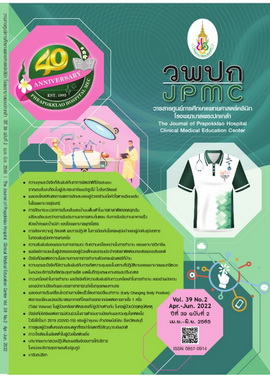Improvement in Sleep Outcomes of Parents with Habitually Snoring Children after Adenotonsillectomy
Main Article Content
Abstract
BACKGROUND: Snoring is a common sleep problem in children, caused primarily by adenotonsillar hypertrophy. Therefore, adenotonsillectomy is recommended as the first-line treatment. Habitual snoring has a negative effect on one’s sleep as well as on the sleep and quality of life of one’s bed partner.
OBJECTIVES: This study aims to determine the impact of adenotonsillectomy on habitually snoring children in terms of parental sleep outcomes, daytime sleepiness, and quality of life in children.
METHODS: In this prospective study, habitually snoring children who underwent adenotonsillectomy at Surin Hospital, and their parents who regularly share beds with them, were enrolled. The parents completed the Functional Outcomes of Sleep Questionnaire (FOSQ), Epworth Sleepiness Scale (ESS), and Quality of Life Questionnaire for Pediatric Obstructive Sleep Apnea (OSA-18) 1 month preoperatively and 1 month postoperatively.
RESULTS: Fifteen parents were recruited. The questionnaires were completed on average 21.1 ±16.7 days before surgery and 38.4±2.5 days after surgery. Postoperative, the mean FOSQ global score improved significantly from 17.1±2.6 to 18.6±1.0 (p=0.03). The mean ESS significantly decreased from 7.1±3.3 to 4.3±3.1 (p=0.009). Significant improvements were also observed in children in the OSA-18 total score, which changed from 66.4±16.4 to 31.3±8.9 (p<0.001) and in all five domains of the questionnaire.
CONCLUSIONS: Adenotonsillectomy has beneficial impacts not only on children’s quality of life but also on the sleep outcomes and daytime sleepiness of their parents. Both the children and their parents reported an improved quality of life and decreased daytime sleepiness following adenotonsillectomy.
Article Details

This work is licensed under a Creative Commons Attribution-NonCommercial-NoDerivatives 4.0 International License.
References
Anuntaseree W, Kuasirikul S, Suntornlohanakul S. Natural history of snoring and obstructive sleep apnea inThai school-age children.Pediatr Pulmonol 2005;39:415-20.
Marcus CL, Brooks LJ, Draper KA, Gozal D, Halbower AC, Jones J, et al. Diagnosis and management of childhood obstructive sleep apnea syndrome. Pediatrics 2012; 130: 576-84.
Luyster FS, Dunbar-Jacob J, Aloia MS, Martire LM, Buysse DJ, Strollo PJ. Patient and partner experiences with obstructive sleep apnea and CPAP treatment: a qualitative analysis. Behav Sleep Med 2016;14:67-84.
Luyster FS. Impact of obstructive sleep apnea and its treatments on partners: a literature review. J Clin Sleep Med 2017;13:467-77.
Todd CA, Bareiss AK, McCoul ED, Rodriguez KH. Adenotonsillectomy for obstructive sleep apnea and quality of life: systematic review and meta-analysis. Otolaryngol Head Neck Surg 2017;157:767-73.
Banhiran W ,Tanphaichitr A, Ungkanont K, Chongkolwatana C, Udomittipong K, Limprayoon K, et al. Long-term impact of adenotonsillectomy on quality of life in Thai children with sleep-disordered breathing. J Med Assoc Thai 2020;103 :736-40.
Cartwright R. Sleeping together: a pilot study of the effects of shared sleeping on adherence to CPAP treatment in obstructive sleep apnea. J Clin Sleep Med 2008;4:123-7.
Weaver TE, Laizner AM, Evans LK, Maislin G, Chugh DK, Lyon K, et al. An instrument to measure functional status outcomes for disorders of excessive sleepiness. Sleep 1997;20:835-43.
Banhiran W, Assanasen P, Metheetrairut C, Nopmaneejumruslers C, Chotinaiwattarakul W, Kerdnoppakhun J. Functional outcomes of sleep in Thai patients with obstructive sleep-disordered breathing. Sleep Breath 2012;16:663-75.
Johns MW. A new method for measuring daytime sleepiness: the Epworth sleepiness scale. Sleep 1991;14:540-5.
Banhiran W, Assanasen P, Nopmaneejumruslers C, Metheetrairut C. Epworth sleepiness scale in obstructive sleep disordered breathing: the reliability and validity of the Thai version. Sleep Breath 2011;15:571-7.
Franco RA, Rosenfeld RM, Rao M. First place--resident clinical science award 1999. Quality of life for children with obstructive sleep apnea. Otolaryngol Head Neck Surg 2000;123(1 Pt 1):9-16.
Kuptanon T, Chukumnerd J, Leejakpai A, Preutthipan A. Reliability and validity of Thai version Quality of Life Questionnaire (OSA-18) for pediatric obstructive sleep apnea. J Med Assoc Thai 2015;98:464-71.
Billings ME, Rosen CL, Auckley D, Benca R, Foldvary-Schaefer N, Iber C, et al. Psychometric performance and responsiveness of the functional outcomes of sleep questionnaire and sleep apnea quality of life instrument in a randomized trial: the HomePAP study. Sleep 2014;37:2017-24.
Sundman J, Friberg D, Bring J, Lowden A, Nagai R, Browaldh N. Sleep quality after modified uvulopalatopharyngoplasty: results from the SKUP3 randomized controlled trial. Sleep [Internet]. 2018 [cited 2020 Jan 15];41(11). Available from: https://academic.oup.com/sleep/article/41/11/zsy173/5106776
American Academy of Sleep Medicine. International classification of sleep disorders. 3rd ed. Darien,IL: American Academy of Sleep Medicine; 2014.

